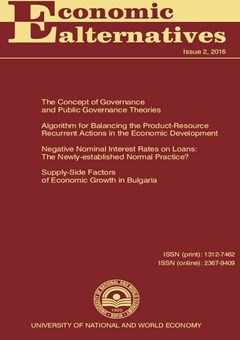Negative Nominal Interest Rates on Loans: The Newly-Established Normal Practice?
Authors: Petar Peshev, Ivaylo Beev
Abstract
The purpose of this article is to initiate a discussion about the central banks’ policy of negative interest rates and its impact on commercial banks’ lending and the bank business model respectively. Recently Bank of Japan joined ECB, Riksbank, Swiss National Bank and Danmarks National Bank in introducing negative interest rates on excess reserves. Extremely accommodative monetary policy of central banks in some of the developed states and economic areas, accompanied by expanding government spending led the world in undiscovered economic reality. Deflation is casting its shadow on developed economies and the rise of bank liabilities is not transmitted into new lending for a healthier economic recovery to evolve. Does the newly established normal practice encompass negative yields on short- and long-term debt, negative interest rates on large private deposits, and even negative interest rates on loans to the private sector? We argue that even with negative nominal lending rates commercial banks still can maintain a viable business model.


